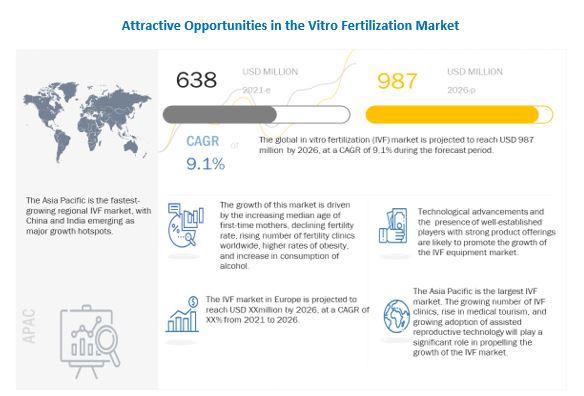Over the years, the median age of first-time mothers has increased significantly across the globe. This trend can largely be attributed to improved contraceptive techniques, late marriages, and the growing number of women prioritizing their careers over starting a family. According to the data published by Australian Institute of Health and Welfare 2021, in Australia the average age of first-time mothers increased from 27.9 years in 2009 to 31.9 years in 2019.
With the median age for first-time mothers increasing, a growing number of women are expected to face difficulties in conceiving naturally. In this scenario, an increasing number of women are forced to opt for IVF treatments; this is expected to drive the growth of the IVF market in the coming years.
[241 Pages Report] The global in vitro fertilization market is projected to reach USD 987 million by 2026 from USD 638 million in 2021, at a CAGR of 9.1% from 2021 to 2026. The key factors propelling the growth of this market include greater public awareness about infertility and the availability of treatment options. However, the high cost and low success rate of IVF treatment and restrictive regulations and ethical concerns are expected to restrict the growth of the IVF market to a certain extent.
COVID-19 pandemic triggered the worldwide suspension of in vitro fertilization treatment; this had a profound impact on women undergoing IVF procedures. In India, 30 lakh people seek IVF every year, but only 5 lakh people undergo IVF/intrauterine insemination (IUI) procedures. During the COVID-19 pandemic, a 90% drop was observed in the number of people undergoing IVF cycles worldwide.

The spread of COVID-19 has not only impacted fertility clinics owing to the cancellation of IVF treatments but has also impacted fertility decisions among couples who had opted for IVF treatment before the pandemic.
Download PDF Brochure @ https://www.marketsandmarkets.com/pdfdownloadNew.asp?id=89198891
The medical tourism industry in emerging countries is thriving owing to a number of factors. Brazil has ~150 centers offering infertility treatments and over 20 medical centers [Source: Fertility Treatment Abroad]. A typical IVF cycle in the US costs around USD 12,000, whereas in Brazil, the same can be completed in USD 4,000.
With more than 500 individual IVF centers, India is one of the most affordable destinations for in vitro fertilization (IVF) and other infertility treatments worldwide. Healthcare treatments cost up to 90% less in India as compared to the USA typical IVF cycle in the US costs around USD 12,000, while in India, the same can be completed in USD 2,000–USD 3,000.
The equipment segment is expected to witness the highest growth rate during the forecast period. The high growth in this owes to the increasing number of IVF procedures and introduction of highly advanced IVF equipment by well-established manufacturers in the market.
